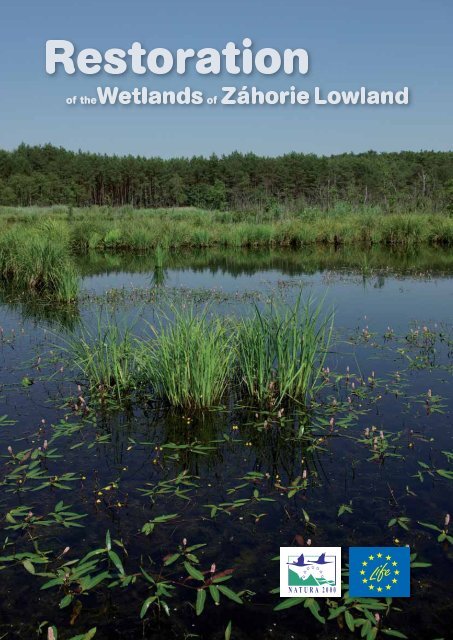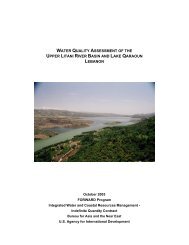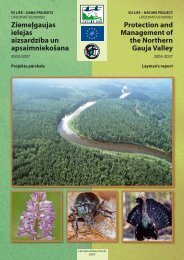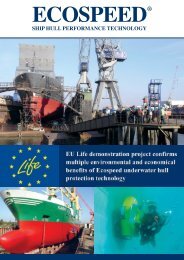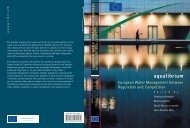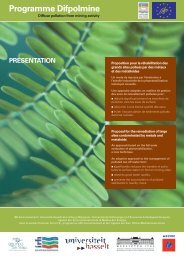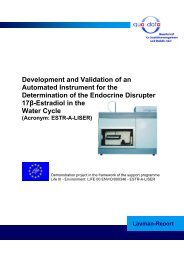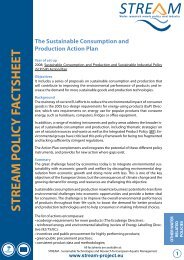RESTORATION OF WETLANDS At - wise-rtd.info
RESTORATION OF WETLANDS At - wise-rtd.info
RESTORATION OF WETLANDS At - wise-rtd.info
Create successful ePaper yourself
Turn your PDF publications into a flip-book with our unique Google optimized e-Paper software.
SCI Mešterova lúka
NATURA 2000<br />
is a coherent European ecological network of special areas of conservation that is being<br />
established within the territory of the EU Member States. The network aims to contribute towards<br />
ensuring biodiversity through the conservation of valuable natural habitats and of endangered<br />
species of wild fauna and flora - i.e. habitats and species of Community interest.<br />
To be a part of the NATURA 2000 network implies great natural values of the site and manifests<br />
an intention to preserve the site as a part of European natural heritage. The European<br />
Commission selects the sites from submitted proposals (National Lists) of the individual<br />
Member states and decides about their incorporation into the NATURA 2000 network.<br />
LIFE PROGRAMME<br />
the European Commission has several financial instruments enabling funding of various<br />
environmental initiatives. One of them is the LIFE Programme which is focused on environmental<br />
and nature protection. The programme’s objective is to contribute to the implementation,<br />
development and enhancement of the Community environmental policy and legislation<br />
as well as the integration of the environment into other EU policies such as economic<br />
and social policies. In order to achieve this, LIFE co-finances projects having a significant<br />
positive impact on the environment.<br />
European Tree Frog (Hyla arborea)
SCI Kotlina<br />
Wetlands represent very important habitats with<br />
the occurrence of many rare and threatened<br />
communities, as well as plant and animal species.<br />
However, nowadays wetlands are among the most seriously<br />
threatened natural ecosystems in Slovakia. In the<br />
last century, especially during its second half, the total<br />
area of wetlands in Slovakia was dramatically reduced<br />
and the vast majority of remaining natural and seminatural<br />
wetlands are seriously threatened by human<br />
intervention. Thousands of hectares of these unique<br />
habitats were sacrificed for drainage, stream regulation,<br />
gravel and peat extraction, development and land<br />
reclamation schemes. The wetlands have been drained<br />
mainly in the lowlands but also on the foothills.<br />
The main purpose of the reclamation schemes was<br />
to gain more arable land for agriculture. However, the<br />
wetlands were also drained in forest areas as a part of<br />
so-called “intensification“ of forest management. Many<br />
wetlands were completely destroyed during this period<br />
and many others seriously damaged.<br />
In Záhorie Lowland (west Slovakia) almost all important<br />
wetlands have been drained. Following the drainage of
Western Marsh Orchid (Dactylorhiza majalis)<br />
White Stork (Ciconia ciconia)<br />
Once these species were quite common in Záhorie region,<br />
but nowadays they are rather rare.<br />
Moor Frog (Rana arvalis)<br />
wetlands, the landscape has dried up in the whole region.<br />
One of the most serious consequences was the<br />
dramatic increase in forest fires. These changes have<br />
lead to the dramatic decline of typical wetland species<br />
and habitats. Many species that were once common<br />
(such as amphibians or storks) have become rare,<br />
some of them even locally extinct.<br />
The grave situation with our wetlands bring us to the<br />
conviction that nowadays it is not enough just to protect<br />
them, but that it is necessary to take more active<br />
measures towards their restoration. Therefore, during<br />
the last two decades we have implemented several<br />
projects focused on the restoration of wetlands, particularly<br />
of their hydrological conditions and biodiversity.<br />
Our project “Restoration of the Wetlands of Záhorie<br />
Lowland“ (WETREST), supported by the LIFE Nature<br />
Programme of the European Commission and implemented<br />
during the years 2005 -2008, is one of the largest<br />
and most successful of such projects in Záhorie<br />
region and in the whole of Slovakia.
Project title: LIFE05NAT/SK/000112 “Restoration of the Wetlands of Záhorie Lowland“ (WETREST)<br />
Starting date: 01/02/2005<br />
Ending date: 31/12/2008<br />
Project beneficiary: State Nature Conservancy of Slovak Republic<br />
Banská Bystrica<br />
Project partners: Slovak Water Management Enterprise<br />
BROZ - Regional Association for Nature Conservation and Sustainable Development<br />
Total project budget: 624 000 EUR<br />
EU financial contribution: 312 000 EUR (50 %)<br />
Financial contribution of beneficiary and partners: 312 000 EUR (50 %)<br />
OBJECTIVE<br />
The main project objective is to contribute to the development of the NATURA 2000 network in the territory of<br />
Záhorie Lowland through the conservation, restoration and enhancement of important wetland habitats and<br />
species. The specific project objectives are:<br />
✿ improving the overall habitat conditions at eight Sites of Community Importance - wetlands degraded in past<br />
by the drainage schemes and other human interventions<br />
✿ reaching and maintaining favourable conservation status of the habitats and species targeted<br />
✿ raising public awareness about wetland restoration / conservation issues
Greater Bladderwort<br />
(Utricularia vulgaris)<br />
Norfolk Hawker<br />
(Aeshna isosceles)<br />
Common Eurasian Spadefoot<br />
(Pelobates fuscus)<br />
SCI Bahno<br />
Restoration of the water<br />
regime in SCI Bahno<br />
SUMMARY <strong>OF</strong> THE PROJECT<br />
The following activities have been performed as a part of project implementation:<br />
✿ Elaboration and implementation of Management Plans and Restoration Projects for the eight most significant<br />
wetlands - Sites of Community Importance (SCI),<br />
✿ Elaboration of amendments to forest management plans so that they are in compliance with the requirements<br />
of nature conservation,<br />
✿ Implementation of specific restoration and management measures - restoration of the water regime of wetlands<br />
(blocking and backfilling drainage ditches, restoration of small streams) and improvement of habitat conditions<br />
for the most threatened plant and animal species,<br />
✿ Construction of a fish by-pass on the Rudava River near Veľké Leváre community in order to enable fish migration<br />
that has been obstructed by the existing weir,<br />
✿ Restoration of species-rich lowland hay meadows along the Rudava River,<br />
✿ Education and training of project personnel, including excursions, seminars and workshops for staff of partner<br />
organizations participating in the project,<br />
✿ Raising public awareness on wetland conservation and restoration through project presentation in the media,<br />
publishing <strong>info</strong>rmation and education materials, organizing lectures and excursions for the general public and<br />
installing <strong>info</strong>rmation panels at project sites.
ký<br />
Šaštín<br />
í<br />
sky<br />
Borský Mikuláš<br />
k potok<br />
Sagels<br />
k potok<br />
l<br />
2<br />
4<br />
1<br />
Bílkove Humence<br />
Lakšárska Nová Ve<br />
s<br />
Mikulášov<br />
3<br />
Žl<br />
i abok<br />
Studienka<br />
Smre<br />
r<br />
k ve<br />
ko<br />
Rudava<br />
Sta<br />
rá<br />
t<br />
v<br />
r Rudava<br />
6<br />
Tr<br />
T<br />
rst nka<br />
The project area consists of eight wetlands - Sites of Community<br />
Importance that are located in the area between the district cities of Malacky<br />
and Senica (west Slovakia). Four of them - Rudava, Orlovské vŕšky,<br />
Mešterova lúka and Kotlina - are situated within Záhorie Military District.<br />
Rudava is also designated as an internationally important wetland (Ramsar<br />
site) according to the Ramsar Convention.<br />
v a<br />
Rudavk<br />
Sološnický<br />
k<br />
potok<br />
Plavecké Podhrad<br />
0 1.25 2.5<br />
k
Identification code: SKUEV0171<br />
SCI name: Zelienka<br />
Cadastral area: Lakšárska Nová Ves, Šaštín<br />
Area: 141,25 ha<br />
Identification code: SKUEV0226<br />
SCI name: Vanišovec<br />
Cadastral area: Šaštín<br />
Area: 202,19 ha<br />
Identification code: SKUEV0120<br />
SCI name: Jasenácke<br />
Cadastral area: Lakšárska Nová Ves<br />
Area: 49,93 ha<br />
Identification code: SKUEV0115<br />
SCI name: Bahno<br />
Cadastral area: Borský Peter<br />
Area: 49,99 ha<br />
Identification code: SKUEV0173<br />
SCI name: Kotlina<br />
Cadastral area: Hlboké, Cerová-Lieskové, Šranek<br />
Area: 638,85 ha<br />
Identification code: SKUEV0163<br />
SCI name: Rudava<br />
Cadastral area: Nivky, Obora, Plavecké Podhradie, Plavecký Mikuláš,<br />
Plavecký Peter, Prievaly, Studienka, Šranek, Záhorie<br />
Area: 1952,38 ha<br />
Identification code: SKUEV0169<br />
SCI name: Orlovské vŕšky<br />
Cadastral area: Riadok, Malacky<br />
Area: 206,92 ha<br />
Identification code: SKUEV0170<br />
SCI name: Mešterova lúka<br />
Cadastral area: Červený Kríž, Malacky<br />
Area: 133,50 ha
The project area is part of the geomorphologic unit Borská nížina lowland (Bor lowland), which is<br />
a part of Záhorie lowland. It stretches over the largest area (about 570 km 2 ) of inland aeolian sands<br />
in Slovakia. Under such specific conditions a diverse mosaic of biotic communities has evolved. Running<br />
and still waters and wetlands alternate with dry sand dunes. Thanks to extraordinary habitat diversity,<br />
there is a high number of species and communities with different ecological requirements present here<br />
in a relatively small area. High biological diversity also occurs because of its location on the edge of three<br />
biogeographical regions - Alpine, Pannonian and Continental. 18 habitats of Community interest and six<br />
habitats of national interest have been recorded in the area. Among them the forest habitats of various<br />
types are represented ranging from fen alder woods to dry pine-oak woods.<br />
Záhorie wetlands scattered in depressions between the sand dunes<br />
resemble small oases in the middle of a desert of aeolian<br />
sands and pine plantations. They stand out because of their immense<br />
diversity of life, since they harbour many plant and animal species that<br />
cannot be found elsewhere. The occurrence of some species such<br />
as Round Leaf Sundew (Drosera rotundifolia), Alpine Bulrush (Trichophorum<br />
alpinum) or Wild Calla (Calla palustris) is indeed remarkable<br />
as they have survived in Záhorie region since the last glaciation when<br />
there was a sub-arctic climate. The tiny Fen Orchid (Liparis loeselii) is<br />
one of the rarest species of Community interest that can be found within<br />
the project area with the project site Rudava harbouring its largest<br />
population in Slovakia.<br />
Round-leaved Sundew<br />
(Drosera rotundifolia)<br />
Water Violet (Hottonia palustris)<br />
Fen Orchid (Liparis loeselii)
W<br />
ith respect to wetland forests, two types of<br />
fen alder woods deserve special attention -<br />
communities of sedge-alder wood and alder wood<br />
with Crested Fern (Dryopteris cristata). In Slovakia<br />
these natural communities with relict species are<br />
now adays to a greater extent only present in Záhorie.<br />
They grow in slacks and along streams where the<br />
ground water level is high. They are also frequently<br />
flooded. The dominant tree species is Common<br />
Alder (Alnus glutinosa) which is the most resistant<br />
of all our native tree species, even against long term<br />
flo oding. Elongated Sedge (Carex elongata) is a charac<br />
teristic species commonly found on the forest<br />
floor of an alder fen. Among the other frequently<br />
found species are Greater Tussock-Sedge (Carex<br />
paniculata), Marsh Cinquefoil (Comarum palustre),<br />
Marsh Fern (Thelypteris palustris), Water Violet<br />
(Hottonia palustris), Yellow Iris (Iris pseudacorus),<br />
European Frog-Bit (Hydrocharis morsus - ranae) and<br />
Marsh Pennywort (Hydrocotyle vulgaris).<br />
Cotton Grass<br />
(Eriophorum spp.)<br />
Yellow Iris (Iris pseudacorus)<br />
As for non-forest wetland habitats, the most remarkable<br />
are transition mires and fens, along<br />
with the natural dystrophic lakes and ponds with their<br />
typical vegetation. Several Peat-moss species can<br />
be found here (e.g. Sphagnum fimbriatum, S. palustre,<br />
S. squarrosum); less common is Cotton Grass<br />
(Eriophorum sp.) or Round Leaf Sundew (Drosera<br />
rotundifolia). In deeper pools there is abundant<br />
cover of yellow-flowering Bladderworts (Utricularia<br />
vulgaris and Utricularia australis) floating on the surface.<br />
Some of the rarest species, such as Bogbean<br />
(Menyanthes trifoliata), Marsh Helleborine (Epipactis<br />
palustris) or Wild Calla (Calla palustris), can be<br />
found only on a few sites.
European Stag Beetle<br />
(Lucanus cervus)<br />
Hermit Beetle<br />
(Osmoderma eremita)<br />
Rhysodes sulcatus<br />
T<br />
he large variety of natural conditions and habitats also results<br />
in a high diversity of fauna, including many rare and threatened<br />
species. The most abundant are invertebrates, of which many<br />
represent glacial relicts. More than 1000 beetle species (Coleoptera)<br />
were recorded within the project area. The majority of rare<br />
beetle species can be found just in wetlands and well-preserved<br />
old-grown forests. The priority species of Community interest<br />
is Hermit Beetle (Osmoderma eremita) living exclusively in old<br />
hollow trees. Dying trees, especially oaks, are an ideal habitat for<br />
European Stag Beetle (Lucanus cervus) and Great Capricorn<br />
Beetle (Cerambyx cerdo), as well as for Rhinoceros Beetle (Oryctes<br />
nasicornis), Flower Beetle (Cetonischema aeruginosa) or the<br />
rare Rhysodes sulcatus.<br />
Butterflies (Lepidoptera) are also species rich. Most species<br />
of Community interest can be found on the meadows along the<br />
Rudava River, such as Scarce Large Blue Butterfly (Maculinea<br />
teleius), Dusky Large Blue Butterfly (Maculinea nausithous) and<br />
Large Copper (Lycaena dispar).<br />
Heath Fritillary (Melitaea athalia)<br />
Rhinoceros Beetle (Oryctes nasicornis)
Dragonflies and damsel-flies (Odonata) are abundant and well recorded, including four species of Community<br />
interest that have been recorded in the area. The Large White-faced Darter Dragonfly (Leucorrhinia<br />
pectoralis) can only be spotted on well-preserved fens. The project area harbours over 90% of its total population<br />
in Slovakia. Unlike the larvae of Green Club-tailed Dragonfly (Ophiogomphus cecilia), which inhabit the sandy<br />
riverbed of the Rudava River, the larvae of Balkan Goldenringed Dragonfly (Cordulegaster heros) prefer the<br />
small forest streams. This is our largest dragonfly and has been only recently discovered in Slovakia, with most of<br />
the records come from Záhorie region. One of the rarest and most threatened European damsel-flies is Ornate<br />
Bluet (Coenagrion ornatum). Its largest population in Slovakia, numbering several hundred individuals, was only<br />
recently discovered within the project area in the upper section of the Rudava River.<br />
One of the most remarkable invertebrates that can be commonly found in Záhorie wetlands is Medicinal Leech<br />
(Hirudo medicinalis). Once used in traditional medicine for “blood-letting“, nowadays it has been re-discovered<br />
and is used by modern medicine for the treatment of some diseases.<br />
Common Darter Dragonfly<br />
(Sympetrum striolatum)<br />
White-faced Darter Dragonfly<br />
(Leucorrhinia pectoralis)<br />
Green Club-tailed Dragonfly<br />
(Ophiogomphus cecilia)
R<br />
eferring to vertebrates, the Rudava River is a home of the rare Ukrainian Brook Lamprey (Eudontomyzon<br />
mariae), which is only known at a few sites in Slovakia and is also ranked among the species of Community<br />
interest. Altogether the Rudava harbours 40 fish species, which represents the highest fish species diversity<br />
among all 55 tributaries of the Morava River.<br />
The fauna of amphibians and reptiles is also abundant and diverse with 18 species. The wetlands represent<br />
important reproduction and breeding habitats for amphibians, some of them living there all the year round.<br />
The most common are Common Newt (Triturus vulgaris), Common Eurasian Spadefoot (Pelobates fuscus),<br />
Moor Frog (Rana arvalis), Agile Frog (Rana dalmatina), European Tree Frog (Hyla arborea) and Common Toad<br />
(Bufo bufo).<br />
Common Newt<br />
(Triturus vulgaris)<br />
Slow-worm (Anguis fragilis)<br />
Common Toad<br />
(Bufo bufo)<br />
Edible Frog (Rana esculenta)<br />
Greylag Goose (Anser anser)
Spined Loach (Cobitis taenia)<br />
Kingfisher<br />
(Alcedo atthis)<br />
I<br />
n wetlands and adjacent forests of the project area there are more than<br />
100 species of birds. Black Stork (Ciconia nigra) is among the rarest<br />
bird species living in the area. It feeds mainly on fish and amphibians. Here<br />
in wetlands it finds both quiet places for nesting and enough food for its<br />
young. Greylag Geese (Anser anser) also occasionally nest here, especially<br />
on larger wetlands with some reed stands.<br />
The European Beaver (Castor fiber) was extinct in the whole of Slovakia<br />
until only 40 years ago. Nowadays it can be commonly found within the project<br />
area. With several hundred individuals, Záhorie region harbours about<br />
90 % of the Slovak population of this largest European rodent. The Otter<br />
(Lutra lutra) can be also spotted in the streams and large water bodies,<br />
though sightings of otters are quite sporadic compared to beavers. Eleven<br />
bat species (Chiroptera) also occur in the area, most of them roosting in<br />
old hollow trees. Populations of game animals such as European Roe Deer<br />
(Capreolus capreolus), Red Deer (Cervus elaphus) and Wild Boar (Sus<br />
scrofa) are also important to mention.<br />
Black Stork<br />
(Ciconia nigra)<br />
Great Egret<br />
(Egretta alba)<br />
European Roe Deer<br />
(Capreolus capreolus)<br />
European Beaver (Castor fiber)...<br />
... and its masterpiece
Intensive forest management in Záhorie region – planting of pine monocultures<br />
instead of natural mixed forests<br />
DRAINAGE, LAND RECLAMATION<br />
AND STREAM REGULATION<br />
Most of the natural wetlands in Záhorie region,<br />
including eight project sites, were drained in<br />
the last century. Almost all free-flowing streams were<br />
regulated. Natural streams have been at least partly<br />
saved mostly within the Záhorie Military District, due<br />
to its specific land use and natural conditions. Many<br />
important wetlands were completely destroyed during<br />
this period, while many others have been seriously damaged.<br />
Following drainage the wetland habitats have<br />
been drying up and gradually deteriorating. Typical<br />
wetland species that were once common disappeared<br />
from the large areas, some of them even became extinct<br />
in the whole region. The retention capacity (ability<br />
to keep and store water) of the drained landscape has<br />
decreased, therefore floods occur more often now and<br />
with more devastating effects. Similarly, draining of<br />
forest wetlands, along with the planting of pine plantations,<br />
has led to a dramatic increase in forest fires.<br />
FOREST MANAGEMENT<br />
Forest management was one of the most serious<br />
factors threatening the natural forests, wetlands<br />
and their biodiversity in Záhorie region. Forest management<br />
practices were focused on maximum timber<br />
production, using large scale clear-fells, removal of the<br />
top soil layer by heavy bulldozers and planting pine monocultures<br />
(plantations) instead of natural mixed forest<br />
stands. Removal of old and hollow trees, largely unprofitable<br />
and senseless, have lead to the loss of nesting<br />
habitats for birds, but also of entire bat colonies and<br />
endangered invertebrates. Forest management also<br />
threatened rare black storks, which are very sensitive<br />
to disturbance, especially during the breeding period.<br />
These forest management practices have been commonly<br />
used almost in the whole Záhorie region, continuously<br />
damaging even the last remaining natural<br />
forest and wetlands habitats and negatively affecting<br />
a wide range of plant and animal species, many of<br />
them listed in the Annexes of the Habitat and Bird<br />
Directives. Most of the valuable forest habitats, including<br />
those located within the Sites of Community Importance,<br />
would be seriously damaged or completely<br />
destroyed if this way of forest management was not<br />
changed.<br />
OVERGROWN MEADOWS<br />
DUE TO ABANDONMENT<br />
Species-rich meadows and pastures within the<br />
Rudava project site require special care as their<br />
continued existence depends on traditional farming<br />
activities – mowing and grazing. Absence of regular<br />
mowing during last two decades has caused the<br />
meadows to be gradually overgrown with weeds and<br />
shrubs resulting in the loss of their formerly rich diversity<br />
of species.<br />
Clear-fell in fen alder wood in proposed SCI Malina (2004)
SCI Mešterova lúka after restoration<br />
of the water regime<br />
Information panel<br />
In general, the project has reached its main objective – to preserve and<br />
restore valuable forest, wetland and meadow habitats with their typical<br />
species in the territory of Záhorie Lowland, thus contributing to the<br />
strengthening of the NATURA 2000 network in that region.<br />
Backfilling<br />
of drainage ditch<br />
• Eight valuable wetlands (Sites of Community Importance), degraded<br />
in the past by drainage, have been successfully restored. After re-filling<br />
of drainage ditches the water conditions and whole ecosystems are returning<br />
back to their natural state. For several decades, these wetlands<br />
were suffering from a lack of water. Now there is enough water even<br />
during dry seasons. The conservation status of the habitats and species<br />
targeted by the project has been remarkably improved and shall<br />
be further maintained as a part of project follow-up. We have even<br />
succeeded in increasing the total area of wetlands within the project<br />
area, along with the abundance of some of their most threatened plant<br />
and animal species.<br />
• The formerly abandoned, overgrown meadows along the Rudava River<br />
have been restored as well. Recently they have started being regularly<br />
mowed again, thus their species richness is maintained.<br />
• In the Sites of Community Importance, forest management has to a large<br />
extent been adapted to the needs of nature conservation. The most<br />
valuable natural forests and wetlands should not be deteriorated by<br />
logging operations anymore, most of them being left with “no management”.<br />
Moreover, more “nature friendly“ forest management methods<br />
have also been introduced outside these SCIs.<br />
MANAGEMENT PLANS<br />
Management Plans have been elaborated for all eight Sites of Community<br />
Importance targeted by the project. These plans represent<br />
the strategic documents for the long-term conservation management of<br />
these sites. Each plan is based on the outcomes of excessive site inventories<br />
carried during the project. It includes the status description for the<br />
site, identifies its future desirable status, and analyses the main conservation<br />
problems and their potential solutions.<br />
Botanical inventory in SCI Bahno
EDUCATION AND TRAINING<br />
<strong>OF</strong> PROJECT PERSONNEL<br />
Key project personnel have been trained in forest and wetland conservation and restoration<br />
topics. For that purpose we have organized four one-week excursions,<br />
two training seminars and several shorter study trips. The first excursion to Pomerania<br />
region, North-West Poland, was organized in June 2006, in cooperation with our Polish<br />
partners implementing the LIFE Nature project LIFE04/NAT/PL/000208 “Conservation<br />
of Baltic raised bogs in Pomerania, Poland”. It was focused on sharing their experience<br />
from the implementation of this LIFE project, as well as their experience with forest<br />
and wetland conservation, restoration and management in this part of Poland. The second<br />
excursion was organized to Šumava National Park (Czech Republic) and Bavarian<br />
Forest National Park (Germany) in October 2006. Its main focus was to learn more<br />
about the restoration of degraded peat lands, as well as to get first-hand experience from<br />
“no management” zones in the spruce forests, disrupted by the bark-beetle. The third<br />
excursion was organized to North-East Poland, in June 2007 in cooperation with the<br />
LIFE Nature project LIFE06/NAT/PL/000105 “Bison Land” - European Bison Conservation<br />
in Bialowieza Forest, Poland. The fourth excursion was organized to East Slovakia<br />
in October 2007, focusing on forest and wetland management in FSC certified forests,<br />
Natura 2000 sites and military training areas.<br />
Besides the project partners, the key stakeholders such as foresters and representatives<br />
of relevant public authorities were also invited to take part in the excursions and training.<br />
This was found to be very useful for the further implementation of the project. During the<br />
excursions they got first-hand experience on nature conservation issues directly related<br />
to the project. For example, they could see that restoration of drained wetlands is not<br />
something specifically exclusive to Záhorie region, but it is just the opposite, a common<br />
approach that is widely used also in other regions. Thanks to the establishment of <strong>info</strong>rmal<br />
contacts between project participants, foresters and other stakeholders, their<br />
mutual acceptance and communication has improved, which was one of the key factors<br />
for the projects’ success.<br />
Non-intervention zone in Šumava (Bohemian Forest) National Park .... inspiration for Záhorie<br />
Restoration of rare peatlands in Poland ....<br />
Peat-bog in Šumava<br />
National Park<br />
and in our homeland in Záhorie region.<br />
.... in Šumava (Bohemian Forest)<br />
National Park ....
Flower Beetle<br />
(Cetonischema aeruginosa)<br />
Grey-headed Woodpecker (Picus canus)<br />
Great Capricorn Beetle<br />
(Cerambyx cerdo)<br />
AMENDMENTS TO FOREST<br />
MANAGEMENT PLANS<br />
The Forest management plan represents the basic<br />
document in forestry planning that specifies in<br />
detail the forest management measures to be implemented<br />
by the responsible forest manager in the<br />
forests concerned within a ten-year period. It is an<br />
obligatory document, required by national legislation,<br />
which has to be elaborated for all forests, including<br />
those in the Sites of Community Importance and protected<br />
areas. Former Forest management plans did<br />
not sufficiently respect nature conservation interests<br />
and needs. Therefore, specific detailed nature conservation<br />
requirements have been formulated for all forest<br />
stands targeted by the project. Following successful<br />
negotiations with foresters, these requirements<br />
(amend ments) were incorporated into the respective<br />
Forest management plans.<br />
Thus in all Sites of Community Importance within the<br />
project area, forest management has to a large extent<br />
been adapted to the needs of nature conservation. The<br />
most valuable natural forests and wetlands should not<br />
be deteriorated by log ging operations anymore, most<br />
of them being left with “no management”. Occasionally<br />
softer forest management methods have been applied:<br />
the previously prevailing logging method “large scale<br />
clear-fell” was replaced by “selective log ging”. The<br />
nesting sites of black storks, as well as of the other<br />
rare species are excluded from logging operations and<br />
the most valuable old and hollow trees are being left<br />
in the worked-out forest stands. Moreover, these softer<br />
forest management methods have been also at least<br />
partly introduced outside the SCIs.
600<br />
1700<br />
2004 2008<br />
Fen Orchid<br />
(Liparis loeselii)<br />
number of flowering individuals<br />
<strong>RESTORATION</strong> <strong>OF</strong> <strong>WETLANDS</strong><br />
<strong>At</strong> eight Sites of Community Importance within the project area we<br />
have restored the wetlands to a total area more than 600 hectares<br />
and on a further 1200 hectares the water conditions of the forest soils<br />
have been substantially improved. Thus the favourable conservation status<br />
of the habitats and species targeted has been reached at a total area<br />
over 1800 ha. Altogether more than 3 kilometres of drainage ditches of<br />
various sizes were filled with sand and soil. Following the completion of restoration<br />
measures, the gradual increase of abundance of typical wetland<br />
species, including those of Community importance, was observed. Especially<br />
in spring and summer time these sites are now virtually overflowing<br />
with a huge diversity of life forms. Hundreds of dragonflies are flying above<br />
the restored wetlands, often reaching far from their edges into the surroundings,<br />
and the voices of frogs and birds can be heard from a distance.<br />
The black storks, herons, wild geese, ducks and other waterfowl have also<br />
re-appeared, searching for food and quiet nesting places.<br />
120<br />
1300<br />
400<br />
2800<br />
1600<br />
4000<br />
2004 2008<br />
Round-leaved Sundew<br />
(Drosera rotundifolia)<br />
number of flowering individuals<br />
2004 2008<br />
Large White-faced Darter Dragonfly<br />
(Leucorrhinia pectoralis)<br />
number of adults<br />
2004 2008<br />
Moor Frog<br />
(Rana arvalis)<br />
number of adults<br />
Increase in abundance of threatened fauna and flora species within<br />
the project area due to implementation of restoration measures<br />
2004 - status before the project 2008 - status at the end of the project<br />
HOW TO RESTORE THE WETLAND<br />
When restoring wetlands, we usually do it in exactly the opposite way to when<br />
they were drained. The unnaturally fast water outflow through the drainage ditches<br />
has to be slowed down or, preferably, completely stopped and the water table in<br />
the ditches should be impounded (increased). For this purpose various types of<br />
constructions, e.g. small earth, wooden or rock-fill dams, sluice-gates, etc. can be<br />
used. However, in the case of smaller ditches, the best solution is their complete<br />
backfilling. Before starting with the restoration works, one has to get the approval<br />
of the landowners and/or land users concerned, as well as all other necessary<br />
permissions. Backfilling of smaller ditches can be done just with simple hand tools<br />
(shovels, spades, picks, wheel-barrows), while for the larger ones usually some<br />
construction machines have to be used, such as excavators or earth-movers.<br />
Following the backfilling of drainage ditches the hydrological regime and the entire<br />
ecosystem gradually return to their natural state prior to drainage. In the case of<br />
smaller wetlands the raising of the water table can be observed within few days, in<br />
larger ones it can take several months or even years. After many years of absence<br />
the water suddenly appears even in the near-by springs and streams that have been<br />
dried-up for decades. Sometimes it even springs from places where nobody would<br />
expect it. Suddenly the air is cooler, the land (vegetation) greener. It is almost unbelievable,<br />
how fast life returns back to the recently restored wetlands. Some species,<br />
such as dragonflies or amphibians, can find a restored wetland within a few hours<br />
or days, while others take much longer. Yet, sooner or later, most of the original<br />
inhabitants reappear and wetland life returns back to its own peaceful way.<br />
9<br />
14<br />
2004 2008<br />
Black Stork<br />
(Ciconia nigra)<br />
number of nesting pairs<br />
60<br />
120<br />
2004 2008<br />
European Beaver<br />
(Castor fiber)<br />
number of individuals
Construction of a fish<br />
by-pass on the Rudava River<br />
Water intake at the fish by-pass<br />
CONSTRUCTION <strong>OF</strong> THE FISH<br />
BY-PASS ON THE RUDAVA RIVER<br />
As part of the regulation scheme that was carried<br />
on the lower section of the Rudava River in<br />
the last century, a weir was built near the community<br />
of Veľké Leváre. For more than half century this<br />
construction formed an obstacle to free fish migration<br />
between the lower and middle sections of the<br />
Rudava River. Several fish species, including those<br />
of Community interest, therefore could not reach<br />
their traditional spawning habitats located upstream<br />
of the barrier. One of the project actions was therefore<br />
focused on the construction of a fish by-pass on<br />
the Rudava River near Veľké Leváre to restore this<br />
important fish migration route.<br />
The whole construction site was located in the territory<br />
of Záhorie military district, therefore obtaining<br />
construction permission and other necessary documents<br />
required intensive communication with the<br />
Slovak Ministry of Defence and its subsidiary institution<br />
Military Forests and Estates of the Slovak Republic<br />
(Vojenské lesy a majetky SR). Thanks to good<br />
cooperation with the responsible military and forestry<br />
authorities and their understanding of the project objectives,<br />
we succeeded step by step to overcome all<br />
administrative obstacles and in 2008 the fish by-pass<br />
was finally built.<br />
By construction of a fish by-pass the problem of a migration<br />
barrier has been solved resulting in free fish<br />
migration in both directions. Unobstructed migration<br />
will have a significant effect on several endangered<br />
fish species e.g. Nase Carp (Chondrostoma nassus),<br />
Burbot (Lota lota) and Vimba (Vimba vimba), whose<br />
traditional spawning sites are located in the upper<br />
parts of the Rudava River watershed. Since the Rudava<br />
is the best preserved tributary of the Morava<br />
River, once the barrier is removed it has a potential<br />
to enable fish reproduction for other fish species as<br />
well and to enhance the fish species diversity in the<br />
Morava River too.<br />
Early monitoring has confirmed that the construction<br />
has fulfilled our expectations and that it is functioning<br />
well and actually used by fish for their migrations.<br />
Thirteen fish species, from a total of 40 living in the<br />
Rudava River, have been found using the by-pass, including<br />
several species of Community interest, such<br />
as Spirlin (Alburnoides bipunctatus), Stone loach<br />
(Barbatula barbatula), Spined loach (Cobitis taenia),<br />
Weather Loach (Misgurnus fossilis) and Bitterling<br />
(Rhodeus amarus). We can just hope that the fish<br />
by-pass (by the way, the first one in Záhorie region<br />
and one of the few in Slovakia) will in the long time<br />
serve its purpose, as well as a model solution to be<br />
repeated at other localities, wherever it is needed.<br />
<strong>RESTORATION</strong> <strong>OF</strong> LOWLAND<br />
MEADOWS ALONG THE RUDAVA<br />
RIVER<br />
Species-rich lowland meadows within the project<br />
site Rudava represent important semi-natural<br />
habitat for many plant and animal species, such as<br />
orchids or rare butterflies. For centuries they have<br />
been traditionally used for mowing and grazing.<br />
However the absence of regular mowing during last<br />
two decades has caused gradual overgrowing of the<br />
meadows with weeds and shrubs, resulting in the<br />
loss of their formerly rich biodiversity. To cope with<br />
this problem we have restored the meadows to a total<br />
area over 165 hectares. <strong>At</strong> first the most overgrown<br />
parts were cleared of woody biomass (shrubs) and<br />
weeds, and then they were mulched. In some areas<br />
the procedure had to be repeated several times.<br />
Finally it was possible to start mowing. For this purpose<br />
a new mowing-machine with mulcher was<br />
purchased from the project budget. Following the<br />
completion of the project, the restored meadows are<br />
being mowed by local farmers, thus their species<br />
richness is further maintained.<br />
The weir built on the Rudava<br />
River in the last century<br />
hindered natural fish migration<br />
for more than 70 years<br />
Mowing the meadows along the Rudava River helps<br />
to sustain their rich biodiversity<br />
Completed upper<br />
section of the fish by-pass
SCI Rudava<br />
RAISING PUBLIC AWARENESS<br />
The knowledge of natural values as well as understanding<br />
the importance of their conservation by<br />
the local people in the region where they live is the best<br />
way for gaining public support for conservation actions.<br />
With public support it is much easier to ensure the implementation<br />
of project activities as well as long-term<br />
sustainability of project achievements.<br />
For this aim several <strong>info</strong>rmation materials were produced<br />
that were distributed mostly in Záhorie region<br />
– small calendars presenting some typical wetland<br />
species, booklet “Wetlands of the European Importance<br />
in Záhorie Military District” and a documentary<br />
film (DVD) on the project “Oases of Life“. <strong>At</strong> six project<br />
sites <strong>info</strong>rmation sign posts for visitors were installed.<br />
The topics of wetland conservation and restoration<br />
have been widely promoted in local, regional and<br />
national media. A special LIFE project web-site<br />
www.wetrest.broz.sk was launched that will continue<br />
after completion of the project.<br />
WORKSHOPS AND PUBLIC<br />
MEETINGS FOR STAKEHOLDERS<br />
Several presentation workshops were organised<br />
that were aimed mainly at the nature conservation<br />
and scientific community. The main purpose of<br />
the workshops was the presentation and <strong>info</strong>rmation<br />
dissemination of the project objectives, activities and<br />
achievements. The participants were mainly external<br />
experts and scientists involved in project implementation,<br />
nature conservationists and members of nature<br />
conservation NGOs. Another purpose of the workshops<br />
was to provide the floor for the exchange of knowledge,<br />
experience, opinions and views among participants.<br />
Part of the workshops were also excursions to the project<br />
sites.<br />
Besides the seminars for experts, public meetings were<br />
organised in the region on which the project objectives<br />
were communicated to local stakeholders and public.<br />
Representatives of local communities, including foresters,<br />
hunters, fishermen, farmers and nature guards<br />
took part in the meetings. With some of them future<br />
cooperation was agreed, sometimes even exceeding<br />
beyond the scope of the project. Hence, nature conservation<br />
actions have gained public support in many<br />
villages of Záhorie region, making good prospects for<br />
the future.<br />
SCI Mešterova lúka<br />
SCI Červený rybník<br />
Jablonové
It is not only nature that benefits from project implementation,<br />
but it is the people of the whole Záhorie<br />
region as well. The wetlands are not just swamps full<br />
of mosquitoes, as many people think, but they can also<br />
bring many profits. Thus the restoration of wetlands is<br />
beneficial not only to preserve these unique habitats<br />
with their rare species, but also for agriculture, forestry,<br />
hunting and fishery. One of the most important functions<br />
of wetlands is the retention of water coming from<br />
rain and snow. This water is naturally released slowly<br />
from wetlands by out-flow and evaporation. In this way<br />
the undisturbed, well functioning wetlands contribute<br />
to the reduction of extreme climate like droughts, floods<br />
or storms. The restoration of their water regime<br />
increases retention capacity of wetlands (i.e. their ability<br />
to retain water), thus reducing the risk of floods in<br />
the whole watershed concerned. Restored wetlands<br />
represent important water supplies during dry seasons<br />
and efficiently prevent the start and spread of forest<br />
fires. This is especially important in the conditions of<br />
dry pine forests of Záhorie, in which such fires are still<br />
fairly common. On hot days, wetland water evaporates<br />
intensively and cools the surroundings, thus improving<br />
the local climate. The increase of air humidity and horizontal<br />
precipitation can be observed even up to several<br />
hundred metres from the edge of the wetland. This<br />
phenomenon positively affects the overall vitality and<br />
health status of the near-by forest stands that would<br />
other<strong>wise</strong> frequently suffer from drought. The spending<br />
made on wetlands restoration thus represents one of<br />
the best investments in the future of the landscape.<br />
The wetlands also provide an important spawning<br />
habitat for some fish species. Thanks to their low<br />
accessibility and sufficient water supply they are also<br />
frequently used by game species as a refuge and<br />
resting place, especially in hot weather. Wetland<br />
restoration also increases the recreational potential of<br />
the area. Most of the locals who are keen mushrooms<br />
pickers are well aware of the fact that during the dry<br />
season it only makes sense to search for mushrooms<br />
close to the wetlands as they cannot grow elsewhere<br />
due to lack of humidity. Thanks to the milder climate<br />
in the wetlands’ surroundings, these have become<br />
a mush room-pickers’ paradise.<br />
<strong>At</strong> the beginning of our efforts to start with wetland<br />
restoration we often had to overcome some distrust,<br />
scepticism and suspicion, especially from the side of<br />
local foresters and hunters. However, project achievements<br />
have convinced most of them that the water<br />
belongs to the forest, and that it was a right decision.<br />
Nowadays, in some hunting districts the hunters themselves<br />
are approaching us, conservationists, to cooperate<br />
further on wetlands restoration to increase their<br />
attraction for game. Thus the LIFE project “Restoration<br />
of the Wetlands of Záhorie Lowland“ has proved that<br />
the conservationists, foresters and hunters can have<br />
common interests that can be implemented together.<br />
Furthermore, the lessons learned from the project can<br />
be applied elsewhere in Slovakia, as well as in the<br />
other European countries, particularly for the benefit<br />
of wetlands as they represent an important part of our<br />
common European natural heritage.<br />
SCI Jasenácke<br />
Black Stork<br />
(Ciconia nigra)<br />
King Bolete<br />
(Boletus edulis)
The LIFE project “Restoration of the Wetlands of Záhorie Lowland“ has established a partner dialogue<br />
and cooperation between nature conservationists, foresters, hunters, water management and<br />
military personnel. However, in Záhorie region and in the whole of Slovakia, there are tens, perhaps<br />
hundreds of wetlands still to be saved or restored. Wetlands and water belong to the landscape, just<br />
like a meadow full of flowers and butterflies, healthy forests overflowing with life, and of course,<br />
also the people who can appreciate and respect it. The role of each generation is the protection of<br />
their heritage from their ancestors, but also retrieval of mistakes made in the past. Restoration of<br />
wetlands, meadows and pastures, introduction of sustainable management in forests, protection of<br />
our most distinguished cultural and natural heritage – these are also the tasks for our generation.<br />
This challenge is our long-term vision for Záhorie and for the whole of Slovakia. In our project we<br />
have demonstrated that it is possible. You are welcome to join us if you wish.<br />
State Nature Conservancy of the Slovak Republic – ŠOP SR (Štátna ochrana prírody SR)<br />
is a public agency for nature and landscape protection. Supervised by the Slovak Ministry of Environment,<br />
it was established in June 2000. The SNC is the principal agency with a national scope entrusted with<br />
coordination and implementation of the NATURA 2000 network in Slovakia. SNC as a project beneficiary<br />
is legally and financially responsible to the European Commission for its proper implementation.<br />
ŠOP SR - Administration of Protected Landscape Area Záhorie<br />
is one of the administration units of ŠOP SR, located in the district city of Malacky. It is responsible for the<br />
practical implementation of nature conservation policies, strategies, programmes and projects within the<br />
Záhorie region (West Slovakia), as well as for the implementation of practical conservation and management<br />
measures to protect natural assets across the whole territory of its competence. Within the project it<br />
was responsible for management plans for SCIs, forest management plans and restoration of meadows.<br />
Slovak Water Management Enterprise (Slovenský vodohospodársky podnik, š.p.,)<br />
is a state organisation supervised by the Slovak Ministry of Environment, founded to serve public interest<br />
in the area of water management. As a project partner it was responsible for the construction of the fish<br />
by-pass on the Rudava River.<br />
BROZ - Regional Association for Nature Conservation and Sustainable Development<br />
(Bratislavské regionálne ochranárske združenie)<br />
was established as a civic association (non-profit, non-governmental organisation) in Bratislava in 1997.<br />
Most of its activities have been focused on nature conservation and restoration of degraded natural ecosystems<br />
in the western part of Slovakia - Danube and Záhorie Lowlands, Danube, Morava and Rudava<br />
Rivers and Malé Karpaty Mts. As a project partner it was responsible for the entire project management,<br />
restoration of wetlands and for the other project actions.<br />
Project LIFE05NAT/SK/000112<br />
“Restoration of the Wetlands<br />
of Záhorie Lowland“ was implemented<br />
with the financial contribution<br />
of the LIFE financial instrument<br />
of the European Community.<br />
Contacts:<br />
State Nature Conservancy of SR<br />
Administration of PLA Záhorie<br />
Vajanského 17<br />
901 01 Malacky<br />
Tel./Fax: (034) 772 2735<br />
www.sopsr.sk/natura<br />
BROZ - Regional Association for Nature Conservation and Sustainable Development<br />
Šancová 96<br />
831 04 Bratislava<br />
Tel./fax: (02) 5556 2693<br />
e-mail: broz@broz.sk<br />
www.broz.sk, www.wetrest.broz.sk<br />
Photos on cover: SCI Zelienka, Four-spotted Chaser (Libellula quadrimaculata) Photos: Bohuš Číčel, Rudolf Jureček, Tomáš Olšovský, Ján Svetlík, Jaromír Šíbl,<br />
Ladislav Štrupl, Jozef Tomeček, Dušan Valachovič, archives of ŠOP SR and BROZ Text: Jaromír Šíbl Proof reading: Mark Sixsmith – www.envenglish.com<br />
Graphic design: Mgr. Ján Svetlík – DUDOK Published: Štátna ochrana prírody SR & BROZ, Banská Bystrica - Bratislava 2008<br />
ISBN: 978-80-89310-53-1


